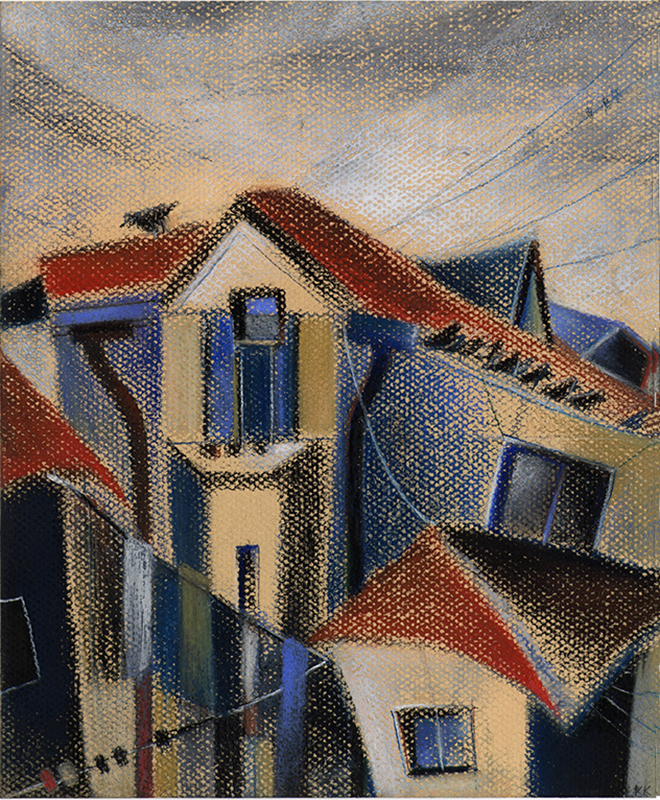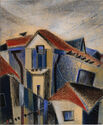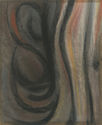
19th, 20th & 21st Century Fine Prints
707-546-7352 · fax 707-546-7924 · web: www.annexgalleries.com · email: artannex@aol.com
(Provincetown roofs) by Karl Knaths



(Provincetown roofs)
Karl Knaths
(Provincetown roofs)
Karl Knaths
1891 - 1971 (biography)Karl Knaths was an American artist whose personal approach to the Cubist aesthetic led him to create paintings which, while abstract, contained readily identifiable subjects. In addition to the Cubist painters, his work shows influence by Paul Cézanne, Wassily Kandinsky, Utagawa Kuniyoshi, Paul Klee, Stuart Davis, and Agnes Weinrich. It is nonetheless, in use of heavy line, rendering of depth, disciplined treatment of color, and architecture of planes, distinctly his own.
This view of the roofs of Provincetown, Mass. was done on a very toothy paper, using pastel and crayon. Knaths allowed the grain of the paper to show through, creating a surface continuity across the angles and dense colors of the composition. In contrast he adds thin, linear components, clothes lines and electric wires that tie the composition together and lead the eye from one area to another. As with a number of his small works he signed with a "KK" in the lower right corner. The verso of the sheet is a portion of another abstract composition.
Karl Knaths was born Otto Karl Knaths in Eau Claire, Wisconsin, on October 21, 1891. After the death of his father when Karl was still a teenager, he was put in the position of supporting the family and took an internship with his uncle, a baker. A chance visit to his high school by author, Zona Gale, proved fortuitous as she encouraged the young Knaths to find the time to pursue art when he could, and upon his graduation, she encouraged him to take courses at the Dudley Crafts Watson school, where he remained until being offered an internship as a theater set designer for the Wisconsin Players in Milwaukee the following year.
In 1911 he traveled to Chicago to enroll at the Art Institute. To support himself, he worked there as a janitor's assistant. Two years into his time at the school the 1913 Armory Show, which premiered in New York and traveled to Chicago and Boston, arrived in town, and he took a job as a guard at the event. This proved to be a turning point in Knaths' artistic path as it was the first time he was exposed to European Modernism. As with many artists and art enthusiasts of the time, the works in Fauvism, Cubism, and Futurism were a mix of confusion, astonishment, and inspiration, and he credits the work of Cezanne with opening the doors to a new way of using color and line.
Knaths would eventually relocate to Provincetown, Massachusetts, following more time with the Wisconsin Players and a two-year military stint. In 1919 he formally set up a studio in the town that was famous for its attraction to artists, and he soon met the Weinrich sisters who had founded the Provincetown Printers. Through this connection he learned the art of woodblock printmaking and was able to form the bold painting style for which he would become known.
In addition to his work as an artist, he developed his own theory regarding style and execution and became a proponent for more naturalistic approaches, writing and teaching about the connection between visual, aural, and written arts. Of note was his observation on schools of style and the paths to learning various techniques: "Systems are only bricks and lumber -- of themselves they cannot encompass the immeasurable spiritual qualities that go into a successful picture. The unlooked-for things that happen in the process of work are the important ones." (Goodrich, Llyod; Howe, John Ireland, 1959: Four American Expressionists: Doris Ceasar, Chaim Gross, Karl Knaths, Abraham Rattner. Whitney Museum of American Art.) His work would eventually begin to explore a more angular, almost Cubist aesthetic, a style he had originally felt intimidated by when observing the works of Picasso at the Armory show.
Knaths was also a noted educator and he taught at Bennington College, Black Mountain College, the Skowhegan School of Painting, and was employed as both a muralist and instructor with the WPA's Federal Art Program. He was also a guest lecturer at various times between 1938 and 1950 at the Phillips Gallery Art School. He first major solo exhibition took place at the Paul Rosenberg Gallery in 1947, and in 1950 he won first prize in the "American Painting Today" competition by the Metropolitan Museum.



